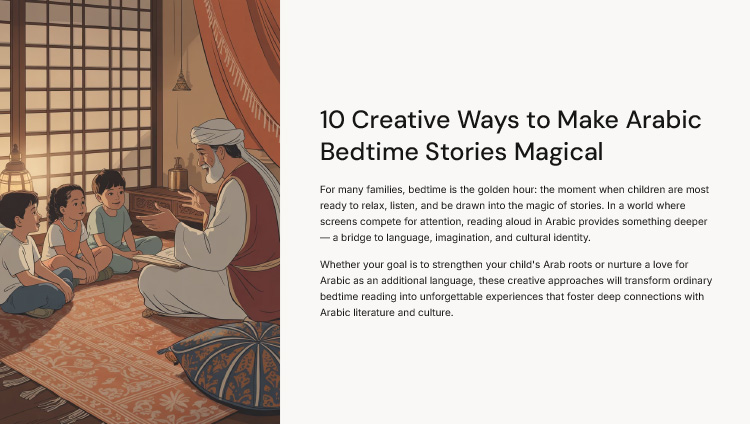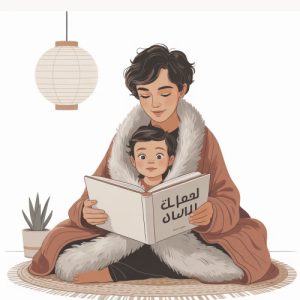
In a world where screens compete for attention, reading aloud in Arabic provides something deeper – a bridge to language, imagination, and cultural identity.
Whether your goal is to strengthen your child’s Arab roots or nurture a love for Arabic as an additional language, these creative approaches will transform ordinary bedtime reading into unforgettable experiences that foster deep connections with Arabic literature and culture.

Children are captivated when stories feel alive through dynamic storytelling. Give each character a unique voice – a deep, booming sound for the wise grandfather, a squeaky tone for the mischievous cat, or a gentle whisper for the kind mother.
Layer in sound effects to create immersive experiences: rustling sounds for desert winds, “clip-clop” rhythms for camel journeys, or dramatic gasps during tense moments. These theatrical elements keep children engaged whilst helping them hear and remember new Arabic words with emotion attached.
This approach particularly benefits heritage learners by connecting familiar cultural sounds with vocabulary, and supports new learners by making unfamiliar words memorable through sensory association.

Transform bedtime stories into theatrical events by incorporating tangible objects. Use a toy falcon to swoop across the bed during adventure tales, wrap a colourful scarf to embody a desert traveller, or gather shells whilst reading coastal stories.
Props make abstract concepts concrete, helping children visualise and connect with Arabic vocabulary in meaningful ways.
Stories don’t have to be stationary experiences. When heroes run, encourage your child to jog on the spot; when falcons soar, flap arms together; when characters dance, sway to imaginary music.
Physical engagement creates kinesthetic learning opportunities that are particularly powerful for connecting body movements with Arabic language acquisition.

Transform passive listening into active participation by pausing at key story moments. Ask thoughtful questions like “What do you think will happen next?” or “Why might the character feel worried?”
This approach builds comprehension skills whilst encouraging children to practise Arabic vocabulary in natural contexts. Even simple responses like lion! represent meaningful victories in language development.
Encourage prediction and analysis to develop critical thinking alongside language skills, making Arabic reading an intellectually engaging experience rather than mere vocabulary practice.
Repetition isn’t tedious for children – it’s comforting and educationally powerful. When stories contain repeated phrases or short poems, encourage your child to join in each appearance.
Over time, they’ll memorise passages word for word, boosting fluency and creating joyful moments of “reading” together, even for beginners. This builds confidence and creates positive associations with Arabic literature.

Children develop deeper connections to Arabic literature when stories link to their personal experiences and family narratives. After finishing a tale about playing outdoors, share memories of climbing palm trees in ancestral villages or experiencing desert landscapes for the first time.
For families with Arab heritage, these connections reinforce cultural identity and create bridges between generations. For families learning Arabic as an additional language, personal anecdotes about travels or cultural encounters in Arab regions make abstract stories feel relevant and meaningful.
This storytelling approach strengthens both linguistic skills and cultural curiosity, helping children understand that Arabic literature reflects real experiences and genuine human connections across time and geography.
Choose stories featuring traditional pearl divers and maritime adventures. As you read, pause to explain the courage required for
deep-sea diving and the economic importance of pearls in Gulf history.
Explore tales of desert caravans and trading journeys. Discuss how camels earned the title “ships of the desert” and the navigation skills needed to cross vast sand landscapes safely.
Share narratives about Bedouin traditions and generous hospitality customs. Explain why generosity remains central to Arab culture and how welcoming strangers reflects deeprooted values.
These cultural explorations make Arabic reading about more than language acquisition – they create meaningful connections with history, traditions, and values that have shaped Arab communities for centuries.

Turn vocabulary recognition into an exciting game by selecting a keyword before beginning each story. For example, when reading moon-themed tales, choose moon as your target word.
Each time the chosen word appears, your child claps enthusiastically, shouts it aloud, or performs a specific action. This playful strategy dramatically improves word recognition and reinforces vocabulary without feeling like formal instruction.
The game approach proves equally effective for heritage learners reinforcing familiar terms and beginners encountering new vocabulary. Success becomes immediately visible and celebrated, building confidence and positive associations with Arabic reading experiences.

Light a special reading lamp, play gentle loud music, or arrange comfortable cushions to signal the transition into Arabic storytelling time.
Begin each session with ceremonial words like tonight’s story to create anticipation and mark Arabic reading as special.
Establish regular timing and routine elements so children develop positive expectations and Arabic storytelling becomes a cherished, non-negotiable part of their day.
Children thrive on predictable routines, and meaningful rituals elevate bedtime reading from simple activity to treasured ceremony. These consistent cues help Arabic literature compete successfully with other entertainment options by creating unique, emotionally satisfying experiences.

Arabic literature offers rich opportunities for meaningful conversation beyond plot comprehension. After completing each tale, engage your child with thoughtful questions: “What important lesson did this story teach us?” or “Which character showed the most kindness?”
For heritage families, these discussions reinforce moral and cultural values tied to identity formation. For families learning Arabic as an additional language, reflective conversations encourage deeper engagement with Arabic texts beyond vocabulary acquisition.
This approach cultivates empathy, critical thinking, and cultural understanding whilst strengthening language skills through natural, purposeful dialogue about literature and life lessons.

Bedtime stories are not merely moments of language practice; they are profound acts of love, heritage, and imagination. By making Arabic storytelling truly magical, you offer your child an enduring gift that extends far beyond childhood.
When you transform ordinary reading sessions into enchanting experiences through voices, props, cultural connections, and meaningful rituals, you create lasting associations between Arabic and beauty, intimacy, and deep meaning.
These magical moments plant seeds that grow into lifelong appreciation for Arabic literature, cultural understanding, and the profound joy found in sharing stories across generations. Your investment in creative storytelling today builds tomorrow’s confident Arabic readers and culturally connected individuals.